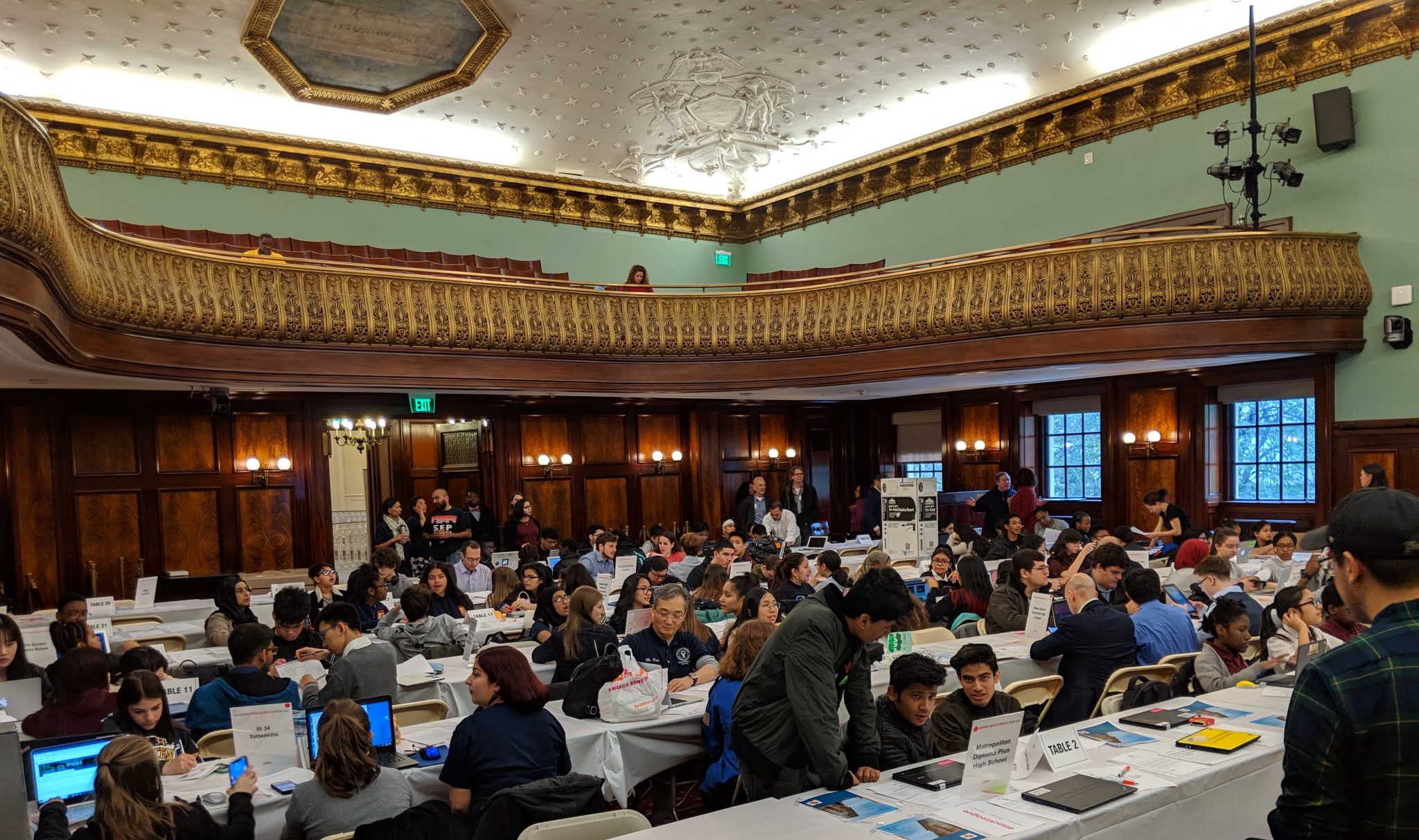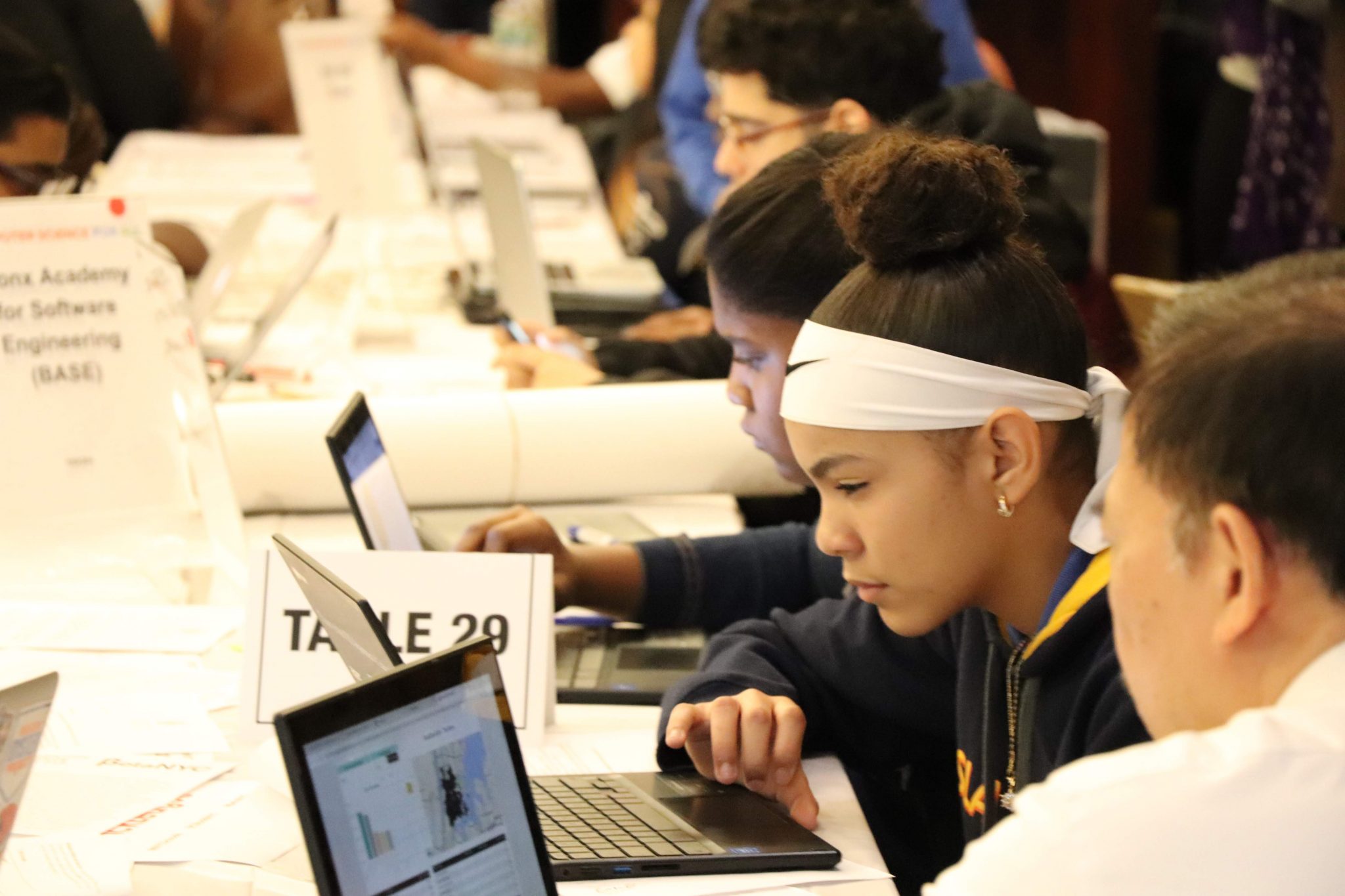A Hackathon At NYC's City Hall
I like going to hackathons. A number of USV portfolio companies have emerged out of hackathons, like our portfolio company Dapper which created its hit crypto-collectible game CryptoKitties at a Hackathon in late 2017.
So yesterday I headed down to NYC’s City Hall which was hosting the finals of a citywide hackathon competition (called The Hack League) among NYC schools to create the best software applications to make the city better.
The final projects were judged by people like the Chief Policy and Data Office (Comptroller’s office); the Chief Analytics Officer (City of NY); the Chief Technology Officer (Mayor’s office); the Executive Director of NYC311 (City of NY) and other folks in city government tasked with a similar mandate.
There were 28 finalist teams at City Hall yesterday competing to win the trophy. They were from all five boroughs, representing schools from all kinds of neighborhoods. It was as diverse as the city is and that is a wonderful thing.
I gave them a pep talk at the start of the day and encouraged them to “instrument their applications” so that they and others can determine how their users are getting value from them.

This is a photo I took of the students as I was about to address them:

The winning teams came from these schools with these applications:
Middle school Winners:
1st: Queens TWYLS – “Trash Go” game that incentivizes proper disposal of trash
2nd: Staten Island IS63 – “Oh Deer” app for residents to report on deer sightings and upload photos so the Dep’t of Environmental Conservation can track the deer
3rd: Brooklyn Parkside Prep – “Hero Foods” app that delivers nutritious lunches to students with special needs (financial or health)
High school Winners:
1st: Brooklyn International HS at Lafayette – “Busted” app for students to report real-time data about buses (such as too full, never arrived)
2nd: Manhattan Bridges High School – “Heat track” app that tracks temperatures inside and outside of homes and communicates to landlords about issues.
3rd: Bronx Millennium Art Academy – “Safety 1st” bi-lingual alert system to keep students informed when they are without their phones during the school day.
I was super impressed by how focused and committed the students were on making their applications better yesterday:

Here is a photo of all of the students who competed yesterday in the City Hall Rotunda.

These are the employees of the future for NYC startups, larger tech companies, and, frankly, every company in NYC. And let me tell you something. They are going to be really good.
Comments (Archived):
The Rotunda photo captures the right ethos.
This is interesting- “so that they and others can determine how their users are getting value from them.”Is that done in the form of built-in reporting?It’s a good idea. We don’t see that even in more advanced and popular Apps.
If you like hackathons, you and Fred should watch me and my friends play golf. It’s really something.
cool.love that building.and really like the diversity of topics in the projects.built in reporting is a great thought to share as it is always important to start projects with a criteria for success and a way to gage that even if it changes of time.
Yes, apparently for some centuries, the standard dream architects have given their clients is just to fill the center of the building with open space several stories high all the way to the roof with at least one, hopefully two, symmetrical staircases.
Stems back I believe to the building of the first mosques way back when. The question is how did they build these types of buildings before they invented scaffolding?Really cool answer if it piques your imagination to look it up.
There was a time when any NYer could just walk inside and enjoy the beauty.
What a great inspiring location 🙂 It’s also really interesting to see what the students deem as problems needing solutions.The future is in good hands.
Hi Fred, been following your blog for about a year and am a huge fan. A few friends and I help run hackathons for high schoolers in Boston (www.metrohacks.org). It’s our mission to introduce CS to students in a fun and engaging manner, and we’re currently planning an event at the Microsoft headquarters in NYC this fall. Any suggestions on how to ensure a diverse event and to get the community excited in NYC?
Who have you engaged locally?
Happy to share some of our process re: Hack League too. Feel free to get in touch with us @betaNYC (kate @ beta . nyc ).
ForThese are the employees of the future for NYC startups, larger tech companies, and, frankly, every company in NYC.I doubt it; if so, then not very well and not for long. Such work won’t give good careers and will do much less well for founding successful startups. The problem is, such hacking just isn’t very valuable now and has value falling quickly. There is value available but not heavily or hardly at all from just hacking.The effort and results look better than I would have expected, but there’s still a dark cloud: What about that stuff will last, have lasting value, last even long enough to get the kids into a marriage and family? Sorry, but maybe not much.Hacking the code is not so difficult, and it will be getting easier, that is, with better designed APIs, documentation, development tools, etc. Too soon, people won’t be paying the big bucks for such work. And for a successful startup, the hacking will be down in the single digits of percent of what is needed.Here’s much of the deal: It’s like people are hungry, don’t have bread or cake, and flour, butter, and sugar are each selling for a penny a ton. That is, the processor cycles, the data storage, and the Internet bandwidth are like the cheap flour, butter, and sugar.E.g., when I was doing AI at IBM’s Watson lab, they had six mainframes for our general purpose use. The little server I plugged together with a $100 processor is — sit down for this — may I have the envelope, please, drum roll, please, and the answer is, “RIP” — at least 35 times faster than all six mainframes put together. Did I mention flour selling for a penny a ton? That’s about the ratio. For storage? Have to sit down again: Can get in the standard 3.5″ form factor, or maybe the 2.5″ one, 14 TB of solid state disk storage. I’m sure that’s WAY more than IBM had for us then. It’s butter at a penny a ton.So, we need to make bread, cake, etc. Or, we need to know what the HECK to DO with all this flour, etc.For that, we need to move uplevel to more of what people can use and want.Then, for much of it, we need to observe that we take in data, process it, and report the results. The processing will necessarily be mathematically something, and for better results proceed mathematically.BELIEVE ME, it doesn’t take much in math to totally blow out of the water with the doors blown off nearly anything that can be done with current artificial intelligence, machine learning, or big data.Heck, have some several TB of log file data that necessarily boils down to just one number, a Poisson process arrival rate. With the math of the Poisson process and the one number, throw all the data away. That is, with the arrival rate and the Poisson process math, can generate TBs of data JUST as useful as all that big data.Or, maybe the data is Gaussian. Okay, slam, bam, thank you ma’am, keep just two numbers, use the Halmos-Savage paper on sufficient statistics, and throw away all the rest of the data as useless. All that’s valuable is just the sufficient statistics math and the two numbers.It goes on this way.E.g., for that central interest in life, people, they are only about 14 dimensional creatures. So, do some principle components, keep the 14 eigen vectors with the 14 largest eigen values, and then for anything want to know there is a little list of 14 numbers can use as a linear combination to get the answer. Maybe have hundreds of things want to know; each needs just 14 numbers and the principle components. Uh, the first principle component? For 100+ years it’s been called IQ.Are we learning yet?If you don’t get it yet, then compare (A) the AI/ML big data approach to predicting where the planets will be in 1000 years with (B) just a few numbers a little math, calculus, and a little physics, Newton’s second law and law of gravity. So, for (A) can struggle and sweat, use R, Python Hadoop, grimace and strain, have training data and test data, use this and that neural networks, fit and adjust, etc. and still not do very well. Or (B) just use the present positions of the planets and Newton’s work and, slam, bam, thank you ma’m, predict the positions of all the planets to an accuracy of a hair of a flea on a gnat.The math or even the moving uplevel are not in the hack a thons or very much in computer science or Sand Hill Road. But it’s coming, if only because there’s not much future in just hacking. Again, the main question is not how to hack but WHAT to hack, what can provide people with what they can use and want.For some hungry people, we need to work up some terrific cakes from the penny a ton flour, butter, and sugar. And for that, competing with or running a Kitchen Aid mixer won’t be much of a career.
I also hope at least a few of them will go into government positions. NYC has some great public sector opportunities at places like NYC Planning Labs. https://planninglabs.nyc/
I like this *so* much. Great initiative and great results. I’m hoping my niece and nephew make an appearance here. One of them just gave a presentation on crypto, so I’m hopeful 🙂
This hackathon league has engaged my son more than anything else he has done in school for the last 3 years. It is a great organization and the self-driven nature of it helps kids develop not just technical, but presentation and team-working skills. (Fred: he def enjoyed your talk)
very cool building for certain.